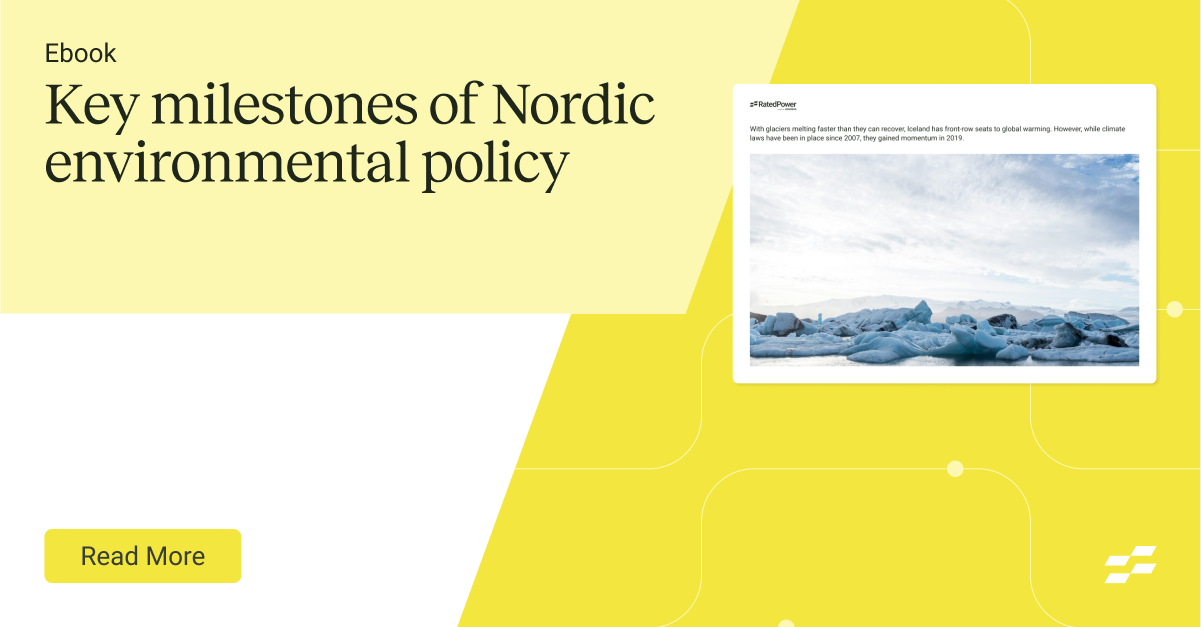- Solar energy blog
- Renewable success stories: the countries with 100% renewable generation
Renewable success stories: the countries with 100% renewable generation
Albania, Bhutan, Nepal, Paraguay, Iceland, Ethiopia, and the Democratic Republic of the Congo generate 100% renewable energy. Read on to find out how they achieved this.


Jeremy Vickerman
Senior Content Manager
Senior Content Marketing Manager at RatedPower with extensive experience in content strategy, production, and communications. Over a decade of expertise spanning marketing, recruitment consulting, and public relations across the UK and Spain, with a strong track record in driving brand visibility and audience engagement.

Almost all of the electricity generated in seven countries around the globe comes from renewable sources. Today, over 99.7% of the electricity produced in Albania, Bhutan, Nepal, Paraguay, Iceland, Ethiopia, and the Democratic Republic of the Congo comes from renewable energy sources like solar, wind, hydro, and geothermal.
Looking for more insights, stats, and opinions on the current state of the renewables sector? Download our Renewable Energy & Solar Research Report 2024 that draws from an industry survey and analysis of solar simulations carried out on the RatedPower Platform.
These countries are proving that the future of energy is already here; we need to capitalize on it.
Seven countries with 100% renewable generation
Let’s look at how these countries have managed to produce nearly all of their electricity from renewable sources.
Albania
Albania generates almost all, 98%, of its electricity from hydropower. Since 2008, the country has increased its hydro capacity by 65%, reaching 2.5 terawatts, an achievement that has helped Albania reach nearly 100% renewable electricity.
Hydropower in Albania
The Albanian government has been actively expanding its hydropower sector. They’ve signed 130 contracts for new plants, with 45 already operating in the Librazhd region. The European Union has also helped substantially, funding eight major projects through the European Bank for Reconstruction and Development.
However, relying heavily on hydropower does pose risks, particularly as climate change impacts water availability. In Albania, projections suggest a decrease in annual precipitation of up to 6.3% by 2050, with the most significant reductions expected during the summer.
Solar and wind power in Albania
To manage these challenges, Albania is expanding its electricity mix. Solar power is now playing a more prominent role, especially during the summer. In 2023, it made up 9% of Albania’s electricity capacity. This increase is supported by projects like the Voltalia photovoltaic park in Karavasta, which is set to power approximately 220,000 households.
Additionally, the EU is supporting Albania with a €333 million investment in wind energy. These efforts are making Albania’s energy supply more stable and diverse as the country reduces its reliance on hydropower.

Bhutan
100% of Bhutan’s electricity comes from hydropower. This is thanks to over 150 plants nationwide, including Mangdechhu, one of the largest hydropower projects that began operating in 2019 and adds 720 MW to the grid. Tala, Chhukha, and Dagachhu are also large plants, contributing 1,020 MW, 336 MW, and 126 MW, respectively.
However, Bhutan’s current installed capacity is only 2,336 MW, which falls well short of its 2020 goal of reaching 10,000 MW. In fact, Bhutan has barely reached 7% of its hydropower potential. More than 35,000 MW of hydropower capacity remains to be developed.
One of the biggest challenges for Bhutan’s hydropower development? Funding. Many initiatives suffered delays and went over budget. There is hope yet, though, as projects like Kholongchhu are overcoming financial obstacles and moving forward. Set to add 600 MW, this project is important for Bhutan’s future energy needs.
Nepal
Nepal mostly relies on hydropower, which accounts for 98.6% of its total electrical output. The remaining 1.4% comes from solar energy.
Although Nepal could produce more than 72,000 MW of electricity, only roughly 2,800 MW have thus far been developed. By 2035, the government aims to increase this to 28,000 MW by investing in projects like the Upper Arun Hydroelectric Plant. Set to open in 2033, the plant will add 1,061 MW to the grid.
Nepal has also started to export electricity, particularly during the wet season when production exceeds domestic demand. Since 2021, the country has been selling power to India and Bangladesh and plans to increase these exports.
Paraguay
Paraguay produces all its electricity from hydropower thanks to its rich river systems. As of 2023, 8,810 MW of capacity had been built, generating around 48 TWh of electricity annually.
While the electricity system in Paraguay meets the country’s needs, it could be improved. According to a study, tapping into more river basins, like those in eastern Paraguay and along the Paraná River, could boost the country’s capacity by an extra 872.7 MW.
Paraguay has also turned its attention to other renewable options like bioenergy, solar, and wind in an effort to diversify its electrical mix.
Iceland
Iceland is rich in natural resources — a benefit that has helped the country achieve 100% renewable energy.
Approximately 75.5% of the country’s electricity comes from hydropower, making it the primary source of electricity. Iceland runs 15 hydroelectric plants, predominantly managed by Landsvirkjun (The National Power Company) along the Þjórsá and Blanda rivers.
The remaining 24.5% comes from geothermal energy. One of the biggest geothermal plants in the world, Hellisheidi, produces 400 MW of thermal energy in addition to 303 MW of electricity.
Most remarkably, Iceland’s electricity generation produces almost no carbon dioxide. At the Hellisheiði Power Station, the Orca facility captures CO2 directly from the atmosphere, further reducing emissions.
If you'd like to learn more about renewables in the Noridcs, this eBook dives into the findings of a Nordic Council study that explores each nation’s key climate policies and suggests strategies for building a more robust regional framework.

Ethiopia
96% of Ethiopia’s electricity comes from hydropower thanks to its many rivers and the Ethiopian Highlands, or Africa’s “water tower.” Wind energy makes up the remaining 4%, with efforts to increase this share.
Although Ethiopia has the potential to generate 260,000 GWh annually from hydropower, only 10% of this capacity has been developed, resulting in an installed capacity of approximately 4,330 MW. The Grand Ethiopian Renaissance Dam, which is about 95% complete, is expected to be fully operational by the end of the year, adding an impressive 6,450 MW to the grid.
Ethiopia is also investing in wind power to vary its sources of electricity. With current projects like the Adama Wind Farms (204 MW) and the Ashegoda Wind Farm (120 MW) already contributing, the EEPCo has identified about 1.3 million MW of wind power potential. Recently, a company from the UAE committed $600 million to construct a 300 MW wind farm, which will be the largest in the country once completed.
Democratic Republic of Congo (DCR)
In the Democratic Republic of the Congo (DCR), 100% of electricity comes from hydropower plants along the Congo basin. Though the country has an estimated capacity of 100,000 MW of hydropower, only 2.5% of it has been developed.
The Inga I and II dams generate 1,775 MW of electricity, making them vital sources for the DRC. There are plans to build Inga III, which will add another 4,400 MW and be used to power mines to supply nearby countries.
The DRC’s main objective is to increase its electricity production. Up to 40,000 MW, or enough power to power most of Africa, will be made by the Grand Inga project. The government is also considering several geothermal and solar energy projects and several businesses are about to sign agreements to use these sources.
Currently, only 19% of people in the DCR have access to electricity. The goal is to increase that number to 32% by 2030.
A renewable future
The countries that have achieved quasi-100% renewable generation have all capitalized on their natural resources, whether large river systems or volcanic heat. As all countries work to increase substantially the share of renewable energy in the global energy mix, we can take inspiration from these seven countries and work to increase our solar, hydro, wind, and geothermal energy capacities.
2025 Trends: Renewable Energy & Solar Research Report
Get key insights and data from an industry-wide survey and solar simulations on the RatedPower platform. Download now to uncover critical trends and challenges shaping the future of renewables.

Latest stories
Related posts
Market analysis
Power where it’s needed: Solving LatAm’s grid instability with distributed solar and storage
Find out how a bottom-up approach is solving LatAm’s grid instability, with community-led solar and storage projects giving people control over their energy.
Updated 29 DEC, 25

Market analysis
Powering through the peak: Why solar + storage is gaining momentum in MENAT
Discover how MENAT is building a functioning solar economy and why rising peak demand during extreme heat is squeezing its energy architecture.
Updated 11 DEC, 25


Market analysis
The rise of utility-scale PV + storage plants in Italy
Discover how Italy’s latest policies and auctions are driving utility-scale solar and battery storage projects to meet ambitious 2030 targets.
Updated 4 DEC, 25

- RatedPower
- Solar energy blog
- Renewable success stories: the countries with 100% renewable generation
 Watch a demo
Watch a demo Ask our AI Product Expert
Ask our AI Product Expert
